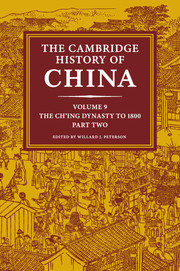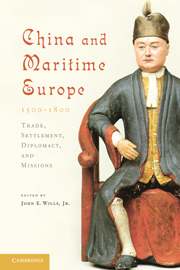42 results
Record of Daily Knowledge and Collected Poems and Essays: Selections. By Gu Yanwu . Translated and edited by Ian Johnston . New York: Columbia University Press, 2017. xviii + 323 pp. $65, £54.95 (cloth), $64.99, £54.95 (ebook).
-
- Journal:
- Journal of Chinese History / Volume 2 / Issue 1 / January 2018
- Published online by Cambridge University Press:
- 25 September 2017, pp. 252-256
-
- Article
-
- You have access
- HTML
- Export citation
Preface
-
- Book:
- The Cambridge History of China
- Published online:
- 05 April 2016
- Print publication:
- 04 April 2016, pp xiii-xiv
-
- Chapter
- Export citation
Introduction: The Ch′ing dynasty, the Ch′ing empire, and the Great Ch′ing integrated domain
-
-
- Book:
- The Cambridge History of China
- Published online:
- 05 April 2016
- Print publication:
- 04 April 2016, pp 1-15
-
- Chapter
- Export citation
Figures and Tables
-
- Book:
- The Cambridge History of China
- Published online:
- 05 April 2016
- Print publication:
- 04 April 2016, pp x-x
-
- Chapter
- Export citation
Bibliography
-
- Book:
- The Cambridge History of China
- Published online:
- 05 April 2016
- Print publication:
- 04 April 2016, pp 701-779
-
- Chapter
- Export citation
Maps
-
- Book:
- The Cambridge History of China
- Published online:
- 05 April 2016
- Print publication:
- 04 April 2016, pp xi-xii
-
- Chapter
- Export citation
Chapter 11 - Arguments over learning based on intuitive knowing in early Ch′ing
-
-
- Book:
- The Cambridge History of China
- Published online:
- 05 April 2016
- Print publication:
- 04 April 2016, pp 458-512
-
- Chapter
- Export citation
Additional material
-
- Book:
- The Cambridge History of China
- Published online:
- 05 April 2016
- Print publication:
- 04 April 2016, pp ii-iii
-
- Chapter
- Export citation
Ch′ing dynasty rulers to 1850
-
- Book:
- The Cambridge History of China
- Published online:
- 05 April 2016
- Print publication:
- 04 April 2016, pp xv-xvi
-
- Chapter
- Export citation
Copyright page
-
- Book:
- The Cambridge History of China
- Published online:
- 05 April 2016
- Print publication:
- 04 April 2016, pp iv-iv
-
- Chapter
- Export citation
Chapter 13 - Dominating learning from above during the K′ang-hsi period
-
-
- Book:
- The Cambridge History of China
- Published online:
- 05 April 2016
- Print publication:
- 04 April 2016, pp 571-605
-
- Chapter
- Export citation
Contents
-
- Book:
- The Cambridge History of China
- Published online:
- 05 April 2016
- Print publication:
- 04 April 2016, pp v-ix
-
- Chapter
- Export citation
Chapter 12 - Advancement of learning in early Ch′ing: Three cases
-
-
- Book:
- The Cambridge History of China
- Published online:
- 05 April 2016
- Print publication:
- 04 April 2016, pp 513-570
-
- Chapter
- Export citation
Glossary–Index
-
- Book:
- The Cambridge History of China
- Published online:
- 05 April 2016
- Print publication:
- 04 April 2016, pp 780-830
-
- Chapter
- Export citation

The Cambridge History of China
-
- Published online:
- 05 April 2016
- Print publication:
- 04 April 2016
Contributors
-
- Book:
- China and Maritime Europe, 1500–1800
- Published online:
- 05 June 2012
- Print publication:
- 31 December 2010, pp vii-viii
-
- Chapter
- Export citation
Conventions
-
- Book:
- China and Maritime Europe, 1500–1800
- Published online:
- 05 June 2012
- Print publication:
- 31 December 2010, pp xiii-xiv
-
- Chapter
- Export citation
Frontmatter
-
- Book:
- China and Maritime Europe, 1500–1800
- Published online:
- 05 June 2012
- Print publication:
- 31 December 2010, pp i-iv
-
- Chapter
- Export citation

China and Maritime Europe, 1500–1800
- Trade, Settlement, Diplomacy, and Missions
-
- Published online:
- 05 June 2012
- Print publication:
- 31 December 2010
Contents
-
- Book:
- China and Maritime Europe, 1500–1800
- Published online:
- 05 June 2012
- Print publication:
- 31 December 2010, pp v-vi
-
- Chapter
- Export citation



